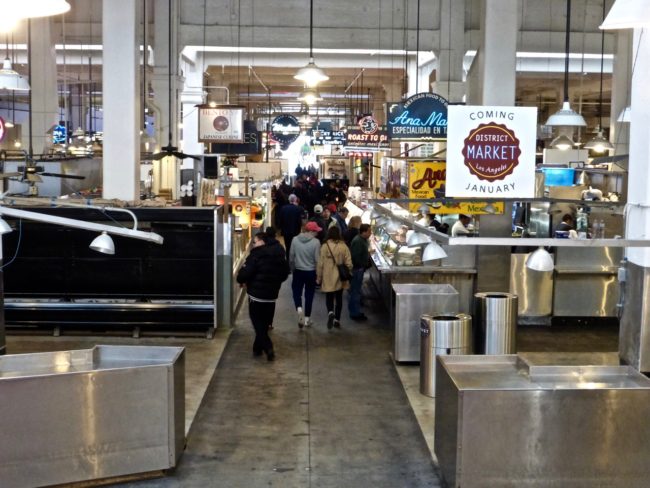
King Tut Los Angeles: Treasures of the Golden Pharaoh
April 18, 2018
Richard Nixon Presidential Library and Museum – Yorba Linda
August 28, 2018Taking Flight
Angels Flight Railway – Los Angeles
Tracy and I had not visited Angels Flight Railway since 2010, a time long ago when I was skinnier, had darker hair and actually not embarrassed to wear San Diego Padres gear in public. Angels Flight has an interesting, and even tragic, history. It remains one of the few local architectural icons that developers have not ruined, yet.
In 1901, in an effort to connect the downtown Los Angeles shopping district below with the posh residential district of Bunker Hill, replete with Victorian frame houses above (see historical photos), the Los Angeles Incline Railway was born.
Known as “The World’s Shortest Railway,” its two counterbalanced passenger cars (dubbed Sinai and Olivet), took L.A. residents up and down the hill (originally 350 feet), running northwest from the west corner of Third and Hill Street two blocks uphill and ended at Olive Street .. all for one penny. In 1915, they raised the fare to a nickel … damn inflation. It opened on New Year’s Eve 1901.
The archway on Hill Street that greeted passengers read “Angels Flight,” and in 1912 the railway was officially titled Angels Flight.
The railway was financed by Colonel J.W. Eddy, a lawyer, and engineer who in his younger years had been a friend of Abraham Lincoln. Angels Flight operated until 1969 when it was shut down as part of a redevelopment project, controversial because it meant displacing 22,000 residents who were living (mostly renting) in the beautifully significant, but rather run-down buildings.
Angels Flight was not destroyed but rather put into storage. The railroad’s arch, station house, drinking fountain, and other artifacts were taken to an outdoor storage yard in Gardena. Sinai and Olivet were sent to a warehouse on Olive Street. Sid and Linda Kastner were the owners of United Business Interiors, and at that location, they also had a private museum named The Bandstand (Dick Clark was not a part of it, however). Along with coin-operated musical instruments, the Kastners also put Sinai on display.
Olivet spent some lonely years in the building’s garage before being rejoined by Sinai.
It was not until 1996 that Angels Flight was removed from storage. It was rebuilt, refurbished and re-opened just a half block away from its original site. I had ridden Angel’s Flight numerous times as a kid with my parents before it was shut down in the late ‘60s, and when it reopened in 1996 many times, I said to Tracy, “We should go downtown and hop on Angels Flight just for old times sake.”
Unfortunately, in 2001, that opportunity was taken away when “Sinai, approaching the upper station, reversed direction and accelerated downhill in an uncontrolled fashion to strike car Olivet near the lower terminus.” It killed an 83-year-old tourist and injured seven others. I thought that would be the end of Angels Flight because maintaining significant historical icons in Los Angeles has never been the city’s strong suit. Fortunately, I was wrong.
It came back in time for our 2010 ride but shut down again in 2013 after another derailment (no deaths this time, but some passengers did need rescuing). It was back up and running in September of 2017 with much fanfare.
Los Angeles Mayor Eric Garcetti said, “This is a railway that always had a little engine that could. It is one of the last relics of Victorian Los Angeles, an iconic LA landmark and it’s right up there with the Griffith Park Observatory and the Hollywood Sign.” (I never miss a chance to get Frankie and Remi in a story.)
That’s when Tracy and I decided to come aboard, but on the day we arrived, Angels Flight was closed with yet more mechanical difficulties.
Finally, in late May 2018, we decided to give it another try and ride those orange and black cars that have had their ups and downs through the years.
We strolled through the “Water Court” at California Plaza, where the water in the fountain wasn’t doing its dance (like it did in this 2010 photo on the right when we visited), and made our way to the Angels Flight upper entrance.
There we reached the Beaux-Arts Station House to purchase tickets.
Once only a penny, tickets now cost a dollar (or you can get a round trip for two).
You’d think they wouldn’t have to post this sign.
We hopped on hoping not for a repeat of 2001.
It only takes about 50 seconds to travel 298 feet to reach the bottom, but I have to admit it brought back some fond memories of my childhood as we hurtled downward (okay, maybe hurtling might be a bit much).
Speaking of kids, there were some on the ride, and they were having a blast. For once, no one was on their phone except to take photos. There was a crowd waiting for the ride to the top.
When you get to the bottom, you’ll find yourself across the street from the historic Grand Central Market (see story here).
Looking up are those daunting 172 steps that take you to the top (unless you wimp out and get the round-trip ticket).
Although not exactly a thrill ride (well, I guess with a previous death on it, it could be considered a thrill ride), the short, football field long trip is fun and, yes, nostalgic.
If you’re in L.A., it’s definitely worth the time, and if you don’t plummet to your death, be sure to meander through the Grand Central Market or perhaps have lunch or dinner at the nearby Maccheroni Republic (new review in a couple of days) that serves the freshest pasta I’ve had in L.A.
Angels Flight
351 South Hill Street (lower station)
California Plaza – 350 Grand Street (upper station)
Los Angeles, California 90013
Open: 365 Days A Year from 6:45 a.m. – 10 p.m.
Cost: $1 or Round Trip for 2 bucks
With the TAP card from METRO – 50¢



































